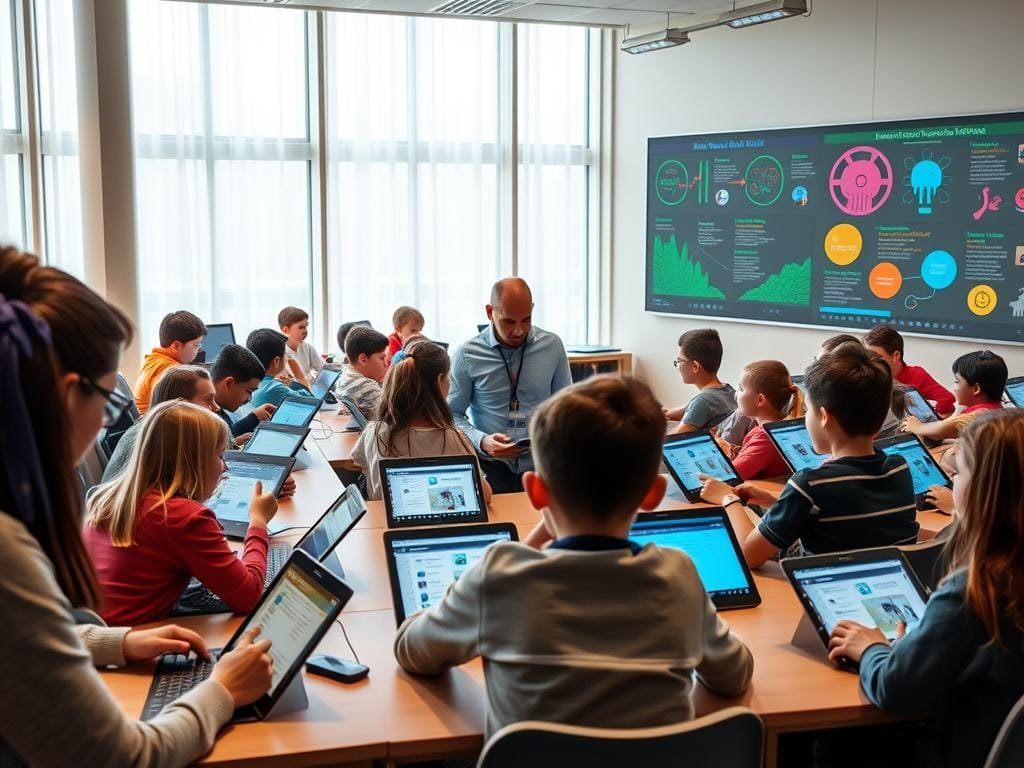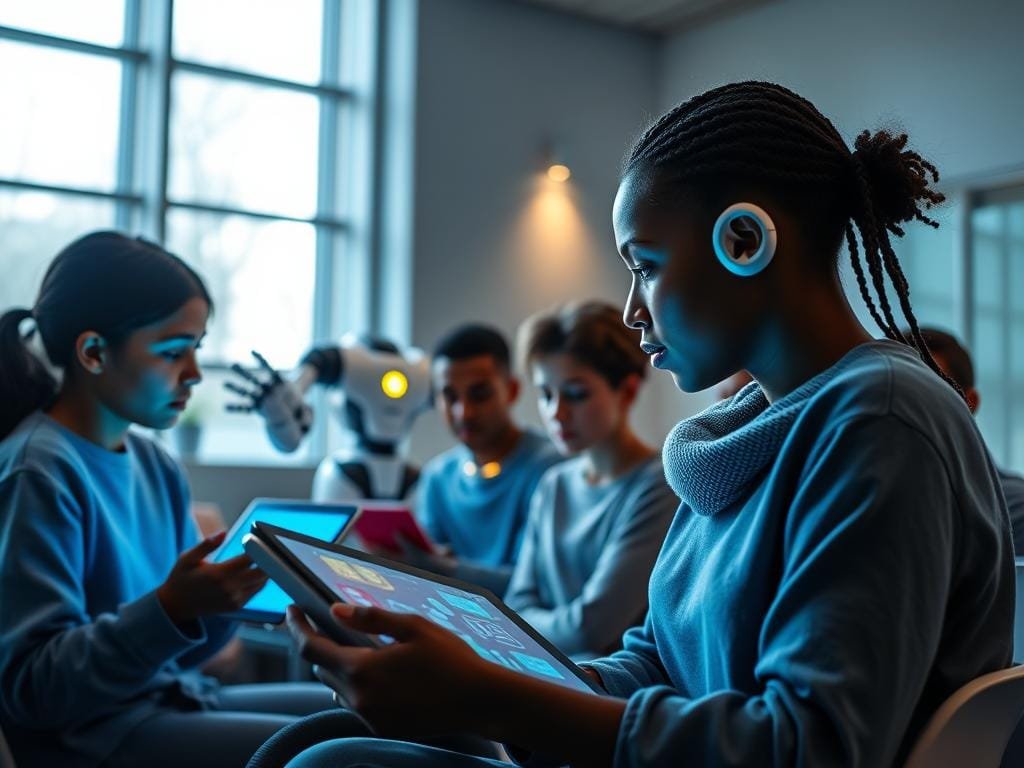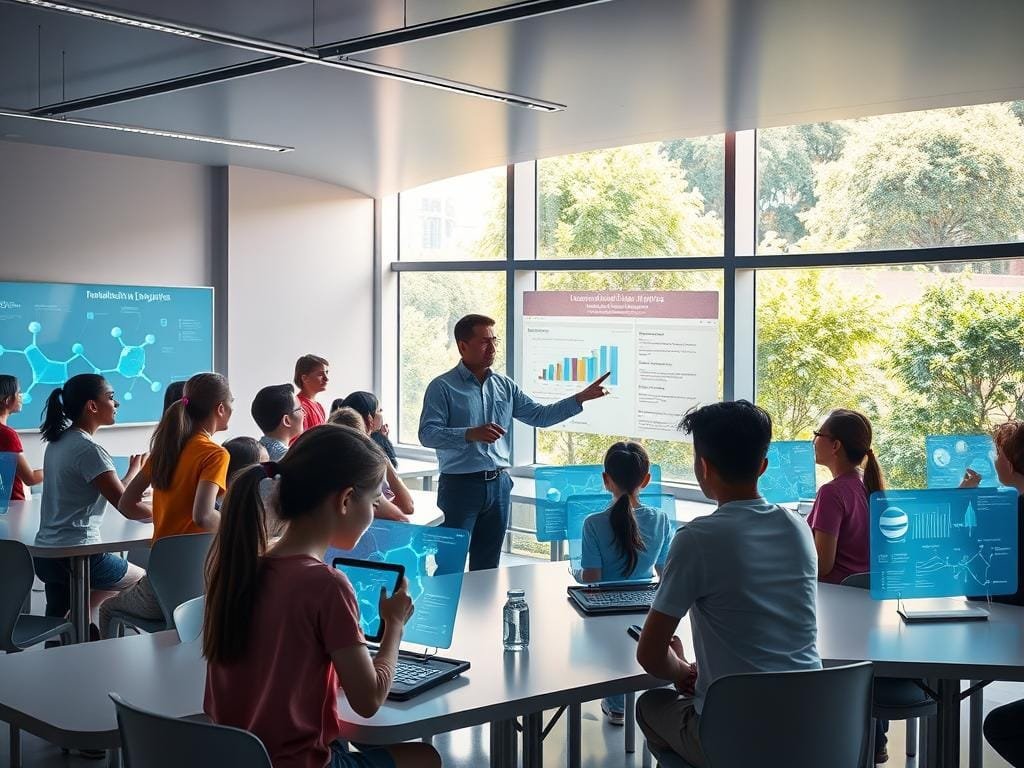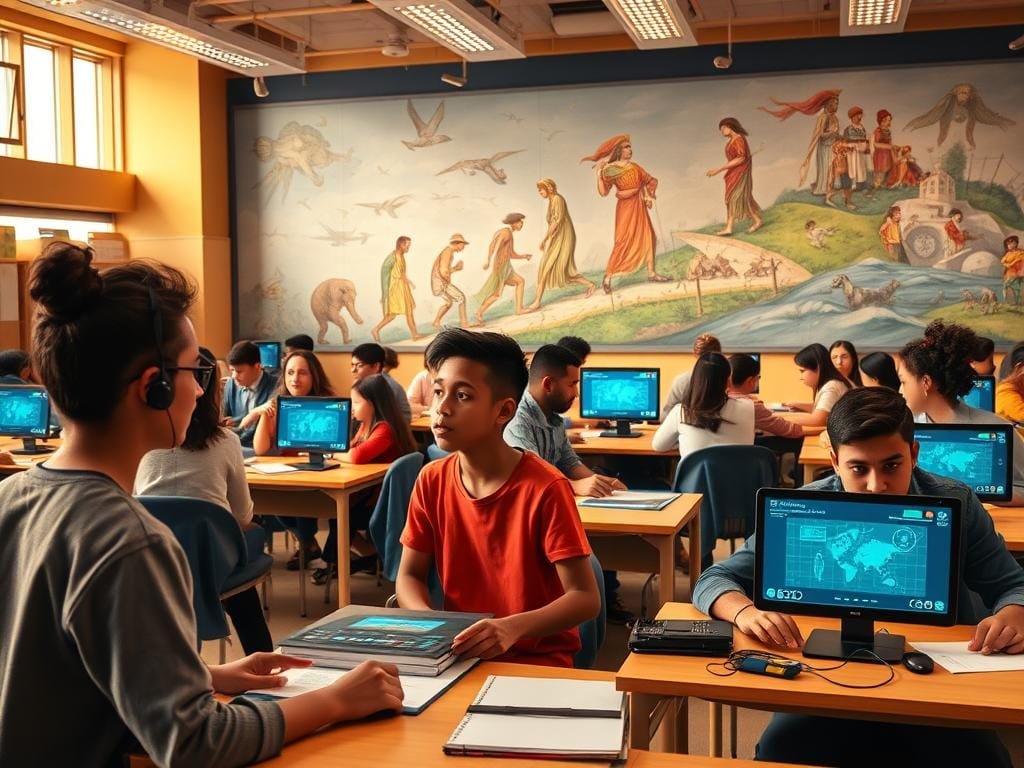A big majority of students, 88%, really believe in AI for personalized learning. They see technology as a key to better learning experiences.
Looking into AI in Education, we see it changing how we learn. A study on Forbes shows AI does more than just improve old ways. It’s changing the classroom for the better.
This change makes learning fit each student’s needs. It could lead to better results in school.
Key Takeaways
- Personalized learning gets a big boost from AI technology.
- 88% of students strongly agree on the importance of AI in their learning.
- AI acts as a virtual tutor and smart helper, aiding in learning.
- The use of AI in education is changing traditional learning.
- AI is meant to help, not replace, human teachers.
Understanding AI in Education
To grasp AI’s role in education, we must first understand what it is and where it came from. As you explore this, you’ll see how AI is changing education.
Definition and Scope of AI in Education
AI in education means using AI to make learning better. It includes adaptive learning technologies that fit each student’s needs. It also includes data analysis tools to help teachers see how students are doing.
AI in education covers a lot of ground. It includes:
- Personalized learning plans
- Intelligent tutoring systems
- Automated grading systems
- Interactive content to keep students engaged
Historical Context and Evolution
AI in education has come a long way. It started in the 1970s and 1980s with Intelligent Tutoring Systems (ITS). Now, it uses advanced machine learning and natural language processing.
| Period | Development | Impact |
|---|---|---|
| 1970s-1980s | Introduction of ITS | First steps in personalized learning |
| 1990s-2000s | Advancements in machine learning | Better adaptive learning technologies |
| 2010s-present | AI in educational platforms | AI tools are now widely used in education |
Today, AI keeps getting better, bringing more advanced and effective learning tools. As you learn more about AI in education, you’ll see its importance growing.
Benefits of Personalized Learning
AI-driven personalized learning is changing classrooms. It makes learning fit each student’s needs. This way, every student gets the help they need to do well.
Tailoring Learning Experiences to Individual Needs
One big benefit of AI in education is tailoring learning to each student. Schools like Arizona State University use AI to create personalized plans. This ensures each student gets the right learning, not too much or too little.
AI helps teachers make customized learning paths for their students. This makes learning more fun and effective for everyone.

Enhancing Student Engagement and Motivation
Personalized learning boosts student engagement and motivation. When learning fits their needs, students are more into it. This makes learning fun and keeps them motivated.
Research shows students do better when learning is personalized. AI helps teachers make learning environments that keep students engaged and motivated.
- Personalized learning experiences lead to higher student engagement.
- AI-driven learning paths improve academic performance.
- Customized education supports diverse student needs.
AI Technologies Transforming Classrooms
AI is changing classrooms in big ways. It’s not just a trend; it’s a real change in how we learn and teach.
Adaptive Learning Platforms
Adaptive learning platforms lead this change. They use machine learning algorithms to adjust learning content based on how students do. For example, Knewton and DreamBox offer intelligent learning systems that give feedback and tailor learning paths.
These platforms use data to find out what students don’t know. They then change the curriculum to fit each student’s needs. This makes learning more fun and effective.

AI-Powered Assessment Tools
AI is also changing how we test students. Tools like these use natural language processing (NLP) and machine learning to check student work. This lets teachers focus more on teaching.
These tools can grade work quickly and accurately. They give students instant feedback. This helps teachers and lets students see where they need to get better.
| Feature | Adaptive Learning Platforms | AI-Powered Assessment Tools |
|---|---|---|
| Primary Function | Personalized learning experiences | Automated grading and feedback |
| Technology Used | Machine learning algorithms | Natural Language Processing (NLP) |
| Benefits | Enhanced student engagement, improved learning outcomes | Reduced teacher workload, immediate student feedback |
As AI keeps changing classrooms, it’s important for teachers and leaders to keep up. By using these new tools, we can make learning better for everyone.
Implementing AI Solutions in Schools
To add AI to your school’s lessons, you must think about a few important things. First, you need to figure out what your students need. Then, you can pick the right technology for them.
Steps for Successful Integration
Adding AI to schools needs a few steps. First, check if your school’s setup can handle AI. Look at your internet, computers, and software.
Next, find out what your students and teachers need. AI can make learning more personal, keep students interested, and help teachers work better.
After knowing what’s needed, pick the right AI tools. This could be learning software, testing tools, or other educational apps. Make sure they work well and fit with what you already have.
| Step | Description | Benefits |
|---|---|---|
| Assess Infrastructure | Evaluate internet connectivity, hardware, and software capabilities. | Ensures compatibility and smooth operation of AI tools. |
| Identify Needs | Understand challenges faced by students and teachers. | Helps in selecting the right AI solutions. |
| Select AI Tools | Choose adaptive learning platforms, AI-powered assessment tools, etc. | Enhances learning experiences and teacher productivity. |
Addressing Common Challenges
When using AI, you might face some problems. One big one is data privacy and security. Make sure the AI tools you pick protect data well and follow the rules.
Another problem is teacher training. Teachers need to know how to use AI tools. Giving them good training and support can help a lot.

By knowing how to integrate AI and solving common problems, you can use AI well in your school. This will make learning better and help students do better in school.
The Role of Educators in an AI-Driven Classroom
AI is changing how teachers work. It’s important to know how AI can help you teach better.
Teacher Training and Professional Development
You need training to use AI tools well. This keeps you up-to-date with new tech and teaching methods. It helps you give your students the best education.
Some key areas for teacher training include:
- Understanding AI capabilities and limitations
- Integrating AI tools into existing curricula
- Using data from AI tools to inform instruction
- Addressing biases in AI algorithms
Investing in your training lets you use AI to make learning more fun and effective.
Collaboration Between Educators and AI Tools
AI is meant to help you, not replace you. Working with AI tools lets you tailor learning to each student’s needs.
AI can handle tasks like grading and data analysis. This gives you more time to teach and mentor.
| Task | AI’s Role | Educator’s Role |
|---|---|---|
| Grading | Automate grading for objective assessments | Review and validate AI-generated grades |
| Data Analysis | Analyze large datasets to identify trends | Interpret results and inform instruction |
| Content Recommendation | Suggest relevant resources based on student needs | Curate and contextualize recommended content |
Working with AI tools makes your classroom more efficient and effective. It benefits both you and your students.

Data Privacy and Security Concerns
AI is changing education, but it raises big questions about privacy and security. Schools collect a lot of data for AI tools. This makes people worry about privacy and the chance of data getting stolen.
Protecting Student Information
Keeping student info safe is very important. Schools must follow laws like FERPA in the US. They need to use strong security to protect student data.
To learn more about AI and privacy in schools, check out https://edly.io/blog/artificial-intelligence-in-education-and-privacy-concerns/.
Best Practices for Safeguarding Data
Schools can do several things to keep data safe. Here are a few:
- Use strong encryption to protect data.
- Do regular security checks to find and fix problems.
- Make sure everyone knows how to handle data safely.
For more on cybersecurity trends, see https://digitalvistaonline.com/overview-of-cybersecurity-in-2025/.
Here’s a quick summary of key data protection practices:
| Practice | Description | Benefit |
|---|---|---|
| Data Encryption | Protects data from unauthorized access | Enhances security |
| Regular Security Audits | Identifies and addresses vulnerabilities | Reduces risk of data breaches |
| Staff Training | Educates staff on data handling best practices | Minimizes human error |
In conclusion, as AI grows in education, keeping data safe is key. Schools must protect student info and use best practices. This way, AI can help education without risking privacy.
Case Studies of AI in Action
AI is changing education in big ways, thanks to case studies and success stories from leading schools. These schools use AI to make learning more personal and effective. This leads to students being more engaged and doing better in their studies.
Success Stories from Progressive Schools
Schools like Arizona State University are using AI to offer customized learning plans. This has greatly improved student results. For example, case studies show AI helps in teaching for sustainable development and opens up digital skills to more people.
AI has not only boosted grades but also made learning more fun. It tailors education to each student’s needs. This keeps students motivated and interested in their studies.
Lessons Learned from Implementation Efforts
Schools have learned a lot from using AI. One key lesson is the need for teacher training and professional development. Teachers must know how to use AI tools well in their classrooms.
Another important lesson is about data privacy and security. Schools must protect student data when using AI platforms.
- Keep AI systems up to date to stay effective and safe.
- Watch over student data to avoid any security issues.
- Work together between teachers and AI tools.
By learning these lessons, schools can handle AI challenges better. This way, they can get the most out of AI for education.
Future Trends in AI and Education
The future of AI in education looks bright. We can expect big steps forward in understanding language and predicting student needs. AI will keep changing how we learn.
Predictions for the Next Decade
In the next ten years, machine learning in education will get even better. This means learning platforms will adapt to each student’s needs. They’ll use lots of data to make learning personal.
AI-powered assessment tools will also become more common. These tools will help teachers see how students are doing. They’ll spot where students need help and act fast.
| Trend | Description | Impact |
|---|---|---|
| Advanced Adaptive Learning | More sophisticated algorithms for personalized learning | Improved student outcomes through tailored learning experiences |
| AI-Powered Assessments | Automated grading and feedback systems | Reduced teacher workload, allowing for more focused instruction |
| Enhanced Accessibility | AI-driven tools for students with disabilities | Increased inclusivity in education |
The Evolving Role of Technology in Learning
AI’s role in education will grow. We’ll see new uses of AI, like virtual and augmented reality in classrooms.
These technologies will make learning fun and easy to understand. AI will also help students work together and with teachers. This will make learning more interactive and supportive.
As we look ahead, it’s important to keep up with AI’s progress. By embracing AI, we can make education better for everyone. It will be more effective, inclusive, and engaging.
Conclusion: Embracing AI for a Better Learning Experience
Exploring AI in Education shows how it’s changing learning. AI helps teachers make lessons that fit each student’s needs. This makes learning more fun and engaging.
To get the most from AI in Education, we need to be open to new ideas. We also have to tackle the challenges of using AI in schools. This means training teachers well so they can use AI tools effectively.
Innovative Approaches to Learning
Using AI wisely can lead to a future where tech and humans work together in education. As AI grows, keeping student data safe is key. We must protect their privacy and security.
A Brighter Future Ahead
Looking ahead, AI in Education could make learning better, faster, and more fun. By embracing AI, we can build a brighter future for everyone in education.
FAQ
What is AI in education, and how does it impact personalized learning?
AI in education uses artificial intelligence to improve learning. It makes learning more personal by matching content to each student’s needs. This makes learning more fun and effective.
How do AI-driven educational systems work?
These systems use algorithms to understand how students learn. They find out what each student knows and what they need to learn. Then, they offer learning plans that fit each student’s style.
What are the benefits of using AI-powered assessment tools in the classroom?
These tools help teachers see how well students are doing. They look at lots of data to find patterns. This helps teachers make better choices for teaching.
How can educators ensure that AI solutions are implemented effectively in schools?
Teachers should first know what each student needs. Then, they should use technology that fits those needs. They also need training to use these tools well.
What are the data privacy and security concerns associated with AI in education?
Using AI in schools raises big questions about keeping student data safe. Schools must protect this data with strong security measures. This includes using encryption and keeping data in safe places.
How can AI enhance student engagement and motivation?
AI makes learning more interesting by tailoring it to each student. It adjusts the level of difficulty and gives feedback right away. This makes learning feel more like a journey for each student.
What is the role of educators in an AI-driven classroom?
Teachers are key in AI classrooms. They work with AI to make learning personal. They need training to use AI tools well and make sure technology helps, not hinders, teaching.
What are the future trends in AI and education?
The future looks bright for AI in schools. We’ll see more AI in learning and testing. As AI gets better, it will change the classroom in exciting ways.
